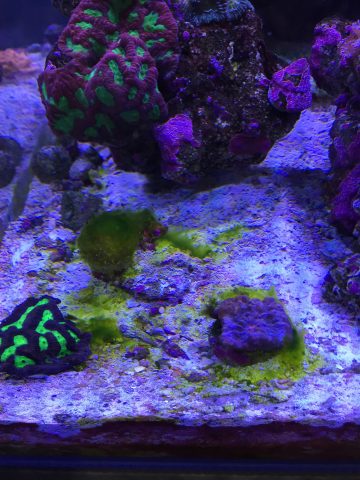Cyanobacteria is a common occurrence in saltwater aquariums. Aquariums under a year old seem particularly prone to outbreaks.
Cyano is typically red. But it can also be brown, blue-green, or even green.
Regardless of the color, it grows in slimy strands that form ‘mats’ on the rock and sand. (To see some great pictures of a typical red cyano out break, check out this page over at Melev’s Reef.)
So, when these green, slimy ‘mats’ began showing up on my rock and then my sand bed a few weeks ago, my first thought was cyanobacteria.

I thought green-colored cyanobacteria was beginning to cover my ball sponge and sand bed…
Howver, my online research soon revealed that cyanobacteria has a little-known relative that looks exactly the same to the naked eye: spirulina algae.
And it’s important to know which one you are up against because the methods for treating the two can be quite different.
How can you determine if it’s cyanobacteria or spirulina algae?
Simple, with a few drops of hydrogen peroxide.
Chances are you already have a bottle sitting in your medicine cabinet. If not, you can pick up a regular bottle of 3% hydrogen peroxide at most any grocery store or corner pharmacy.
Simply place a few clumps of the cyano into a container along with 2 cups of water from your aquarium.
Add 1 ml (20 drops) of hydrogen peroxide to it and then let it sit for several hours.
Peroxide is deadly to cyanobacteria. It easily breaks the cyano down and kills it. But peroxide has absolutely NO effect on spirulina algae.
So…
If the water turns the same color as the cyano, it means you are indeed up against cyanobacteria.
If the water remains clear and the ‘cyano’ clumps show absolutely no signs of dissolving, then it is NOT cyanobacteria.
There are several methods you can use to get rid of cyano.
Many aquarists use the old-school method of keeping their tank lights off and the entire room dim for 3 days in order to starve it of light.
In some cases this isn’t enough to do the trick though and the cyano returns a few days after the lights are turned back on.
Others recommend dosing the aquarium with peroxide using a dosage of 1 ml of peroxide for every 10 gallons of water twice per day for 14 days straight.
Mild doses of peroxide have been proven to wipe out cyano while being safe on all other tank inhabitants.
And still others swear by the use of products like ChemiClean and Red Slime Stain Remover.
In fact, Chemiclean will eliminate both cyanobacteria and spirulina.
From what I’ve read, the key to success with products like these is to follow the direction to the tee. That means making sure you oxygenate the water as much as possible with powerheads and/or air stones. And doing the recommended water change as soon as the treatment is complete.
As for me, well, the water in my test stayed clear so it’s not cyano. That means it’s either spirulina or some other form of algae.
I’m going to give my tank a few more weeks to see if regular water changes will lower my nutrient levels enough to both starve it out and bring my good bacteria back into balance with the bad bacteria.
If so, the outbreak I’m experiencing may clear up on it’s own.
If it doesn’t, I’ll probably pay Amazon.com a visit and order some Chemiclean.
